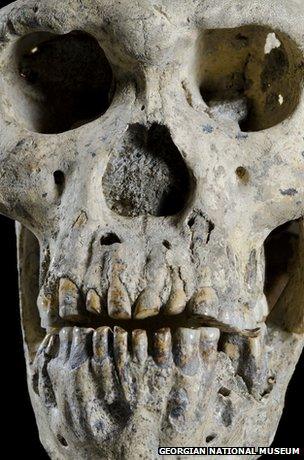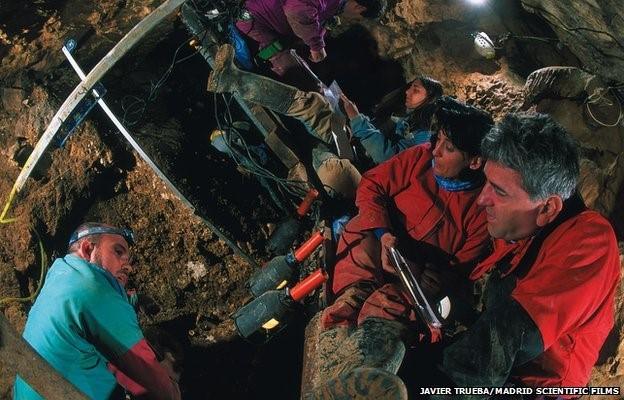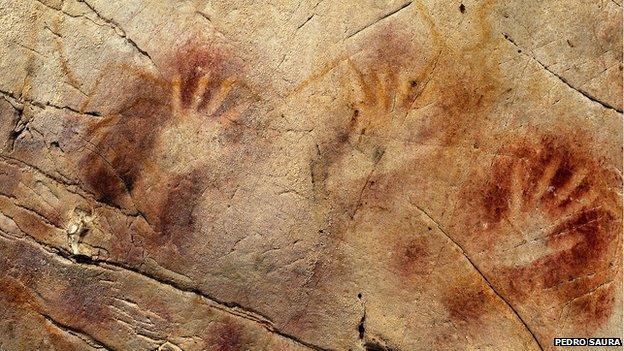Viewpoint: Human evolution, from tree to braid
- Published

One and the same: What many thought of as three separate species may in fact be just one
If one human evolution paper published in 2013 sticks in my mind above all others, it has to be the wonderful report in the 18 October issue, external of the journal Science.
The article in question described the beautiful fifth skull from Dmanisi in Georgia. Most commentators and colleagues were full of praise, but controversy soon reared its ugly head.
What was, in my view, a logical conclusion reached by the authors was too much for some researchers to take.
The conclusion of the Dmanisi study was that the variation in skull shape and morphology observed in this small sample, derived from a single population of Homo erectus, matched the entire variation observed among African fossils ascribed to three species - H. erectus, H. habilis and H. rudolfensis.
The five highly variable Dmanisi fossils belonged to a single population of H. erectus, so how could we argue any longer that similar variation among spatially and temporally widely distributed fossils in Africa reflected differences between species? They all had to be the same species.
I have been advocating that the morphological differences observed within fossils typically ascribed to Homo sapiens (the so-called modern humans) and the Neanderthals fall within the variation observable in a single species.
It was not surprising to find that Neanderthals and modern humans interbred, a clear expectation of the biological species concept.
But most people were surprised with that particular discovery, as indeed they were with the fifth skull and many other recent discoveries, for example the "Hobbit", external from the Indonesian island of Flores.
It seems that almost every other discovery in palaeoanthropology is reported as a surprise. I wonder when the penny will drop: when we have five pieces of a 5,000-piece jigsaw puzzle, every new bit that we add is likely to change the picture.
Did we really think that having just a minuscule residue of our long and diverse past was enough for us to tell humanity's story?
If the fossils of 1.8 or so million years ago and those of the more recent Neanderthal-modern human era were all part of a single, morphologically diverse, species with a wide geographical range, what is there to suggest that it would have been any different in the intervening periods?
Probably not so different if we take the latest finds from the Altai Mountains in Siberia into account. Denisova Cave has produced yet another surprise, revealing that, not only was there gene flow between Neanderthals, Denisovans and modern humans, but that a fourth player was also involved in the gene-exchange game.
The identity of the fourth player remains unknown but it was an ancient lineage that had been separate for probably over a million years. H. erectus seems a likely candidate. Whatever the name we choose to give this mystery lineage, what these results show is that gene flow was possible not just among contemporaries but also between ancient and more modern lineages.

A femur recovered from the famed "Pit of Bones" site in Spain yielded 400,000-year-old DNA
Just to show how little we really know of the human story, another genetic surprise has confounded palaeoanthropologists. Scientists succeeded in extracting the most ancient mitochondrial DNA so far, from the Sima de los Huesos site in Atapuerca, Spain.
The morphology of these well-known Middle Pleistocene (approximately 400,000 years old) fossils have long been thought to represent a lineage leading to the Neanderthals.
When the results came in they were actually closer to the 40,000 year-old Denisovans from Siberia. We can speculate on the result but others have offered enough alternatives for me to not to have to add to them.
The conclusion that I derive takes me back to Dmanisi: We have built a picture of our evolution based on the morphology of fossils and it was wrong.
We just cannot place so much taxonomic weight on a handful of skulls when we know how plastic - or easily changeable - skull shape is in humans. And our paradigms must also change.

Old assumptions are being challenged as new thinking emerges
Some time ago we replaced a linear view of our evolution by one represented by a branching tree. It is now time to replace it with that of an interwoven plexus of genetic lineages that branch out and fuse once again with the passage of time.
This means, of course, that we must abandon, once and for all, views of modern human superiority over archaic (ancient) humans. The terms "archaic" and "modern" lose all meaning as do concepts of modern human replacement of all other lineages.
It also releases us from the deep-rooted shackles that have sought to link human evolution with stone tool-making technological stages - the Stone Ages - even when we have known that these have overlapped with each other for half-a-million years in some instances.
The world of our biological and cultural evolution was far too fluid for us to constrain it into a few stages linked by transitions.
The challenge must now be to try and learn as much as we can of the detail. We have to flesh out the genetic information and this is where archaeology comes into the picture. We may never know how the Denisovans earned a living, after all we have mere fragments of their anatomy at our disposal, let alone other populations that we may not even be aware of.
What we can do is try to understand the spectrum of potential responses of human populations to different environmental conditions and how culture has intervened in these relationships. The Neanderthals will be central to our understanding of the possibilities because they have been so well studied.
A recent paper, for example, supports the view that Neanderthals at La Chapelle-aux-Saints in France intentionally buried their dead, external which contrasts with reports of cannibalistic behaviour not far away at El Sidron in northern Spain.
Here we have two very different behavioural patterns within Neanderthals. Similarly, modern humans in south-western Europe painted in cave walls for a limited period but many contemporaries did not. Some Neanderthals did it in a completely different way it seems, by selecting raptor feathers of particular colours. Rather than focus on differences between modern humans and Neanderthals, what the examples show is the range of possibilities open to humans (Neanderthals included) in different circumstances.
The future of human origins research will need to focus along three axes:
further genetic research to clarify the relationship of lineages and the history of humans;
research using new technology on old archaeological sites, as at La Chapelle; and
research at sites that currently retain huge potential for new discoveries.
Sites in the latter category are few and far between. In Europe at least, many were excavated during the last century but there are some outstanding examples remaining. Gorham's and Vanguard Caves in Gibraltar, where I work, are among those because they span over 100,000 years of occupation and are veritable repositories of data.
There is another dimension to this story. It seems that the global community is coming round to recognising the value of key sites that document human evolution.
In 2012, the caves on Mount Carmel, external were inscribed on the Unesco World Heritage List and the UK Government will be putting, external Gorham's and associated caves on the Rock of Gibraltar forward for similar status in January 2015. It is recognition of the value of these caves as archives of the way of life and the environments of people long gone but who are very much a part of our story.
Prof Clive Finlayson is director of the Gibraltar Museum and author of the book The Improbable Primate.

The UK government is to seek World Heritage status for Gorham's and associated caves on the Rock
- Published4 December 2013
- Published17 October 2013
- Published18 December 2013